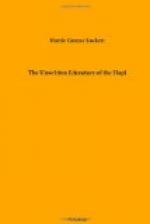* * * * *
One of the most pleasant memories the writer has kept of her Hopi story-tellers is that of wholesome Mother Sacknumptewa of Oraibi. She must be middle-aged, and is surprisingly young-looking to be the mother of her big family of grown-up sons and daughters. She wore a brand-new dress of pretty yellow and white print, made in the full Hopi manner, and her abundant black hair was so clean and well brushed that it was actually glossy. Her house was spic and span and shining with a new interior coat of white gypsum.
Her long Indian name, Guanyanum, means “all the colors of the butterflies.”
It was late afternoon, and she sat on the clean clay floor of her house and husked a great pile of young green corn for supper, as she told me the two little fables that follow. There was a poise and graciousness about this woman, quite outstanding; yet she was a simple, smiling, motherly person who often laughed quietly, or broke into a rhythmic crooning song as she imitated her characters.
Several of her grown children gathered round and laughed with hearty approval at her impersonations, and at last her husband came in smiling and sat near, joining in the songs of the frog and the locust, to the great merriment of their children.
=The Coyote and the Turtle,= as told by Guanyanum Sacknumptewa
“A long time ago, there were many turtles living in the Little Colorado River near Homolovi, southeast of Winslow, where Hopi used to live. And there was a coyote living there too, and of course, he was always hungry.
“Now one day the turtles decided they would climb out of the river and go hunt some food, for there was a kind of cactus around there that they like very much. But one of the turtles had a baby and she didn’t like to wake it up and take it with her because it was sleeping so nicely. So they just went along and left the baby asleep.
“After a while the little turtle woke up and he said, ’Where is my mother? She must have gone somewhere and left me. O, I must go and find her!’
“So the baby turtle saw that the others had crawled up the bank, and he followed their tracks for a little way. But he soon got tired and just stopped under a bush and began to cry. (Note: Her imitation of the crying was good. H.G.L.)
“Now the coyote was coming along and he heard the poor little turtle crying. So he came up and said, ’That’s a pretty song; now go on and sing for me.’
“But the baby turtle said, I’m not singing, I’m crying.’
“‘Go on and sing,’ said the coyote, ‘I want to hear you sing.’
“‘I can’t sing,’ said the poor baby, ‘I’m crying and I want my mother.’
“‘You’d better sing for me, or I’ll eat you up,’ said the big hungry coyote.
“‘O, I can’t sing—I just can’t stop crying,’ said the baby, and he cried harder and harder.
“‘Well,’ the big coyote said, ’if you don’t sing for me I’m going to eat you right up.’ The coyote was mad, and he was very hungry. ’All right, then, I’ll just eat you,’ he said.




